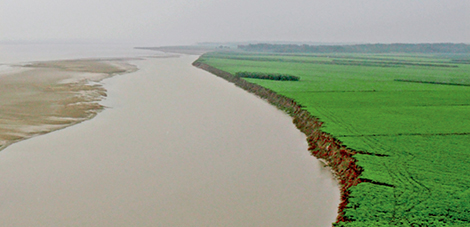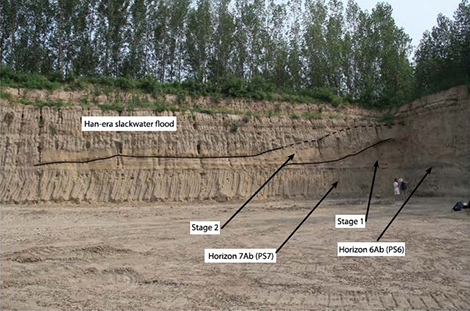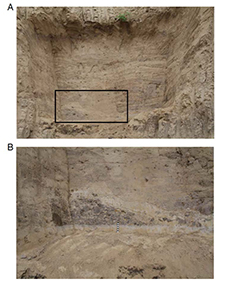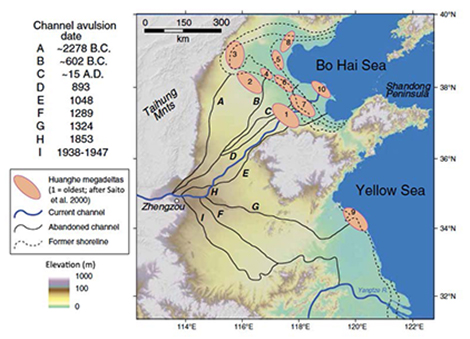Article Body 2010
Known as the “cradle of Chinese
civilization,” the Yellow River was the birthplace of the prosperous
northern Chinese civilizations in early Chinese history. However, the
Yellow River is also referred to as “China’s Sorrow” because of its
frequent and devastating flooding.
Research maps and images courtesy of the Journal of Archaeological and Anthropological Sciences.
For thousands of years, Mother Nature has taken the blame for tremendous
human suffering caused by massive flooding along the Yellow River, long
known in China as the “River of Sorrow” and “Scourge of the Sons of
Han.”
Now, new research from Washington University in St. Louis links the
river’s increasingly deadly floods to a widespread pattern of
human-caused environmental degradation and related flood-mitigation
efforts that began changing the river’s natural flow nearly 3,000 years
ago.
WUSTL archaeologist T.R. Kidder excavates at Sanyangzhuang, an ancient, flood-buried community known as China’s Pompeii.
“Human intervention in the Chinese environment is relatively massive,
remarkably early and nowhere more keenly witnessed than in attempts to
harness the Yellow River,” said T.R. Kidder, PhD, lead author of the
study and an archaeologist at Washington University.
“In some ways, these findings offer a new benchmark for the beginning
of the Anthropocene, the epoch in which humans became the most dominant
global force in nature.”
Forthcoming in the Journal of Archaeological and Anthropological
Sciences, the study offers the earliest known archaeological evidence
for human construction of large-scale levees and other flood-control
systems in China.
A catastrophic flood
It also suggests that the Chinese government’s long-running efforts
to tame the Yellow River with levees, dikes and drainage ditches
actually made periodic flooding much worse, setting the stage for a
catastrophic flood circa A.D. 14-17, which likely killed millions and
triggered the collapse of the Western Han Dynasty.
“New evidence from China and elsewhere show us that past societies
changed environments far more than we’ve ever suspected,” said Kidder,
the Edward S. and Tedi Macias Professor in Arts & Sciences and chair
of anthropology at WUSTL. “By 2,000 years ago, people were controlling
the Yellow River, or at least thought they were controlling it, and
that’s the problem.”
Kidder’s research, co-authored with Liu Haiwang, senior researcher at
China’s Henan Provincial Institute of Cultural Relics and Archaeology,
relies on a sophisticated analysis of sedimentary soils deposited along
the Yellow River over thousands of years.
Locator Map: The Yellow River
Vallley of China, with Box A identifying the flood plain regions
researched in this study.The star in Box B is the location of the
Anshang and Sanyangzhuang sites. The approximate extent of the Loess
Plateau is indicated by shading. VIEW LARGER>
It includes data from the team’s ongoing excavations at the sites of
two ancient communities in the lower Yellow River flood plain of China’s
Henan province.
The Sanyangzhuang site, known today as “China’s Pompeii,” was slowly
buried beneath five meters of sediment during a massive flood circa A.D.
14–17, leading to exceptional preservation of its buildings, fields,
roads and wells.
The Anshang site, discovered in 2012, includes the remains of a
human-constructed levee and three irrigation/drainage ditches dating to
the Zhou Dynasty (c. 1046–256 BC).
Researchers examined about 50 vertical feet of exposed
soil layers at the Anshang site, carefully cleaning sections of a quarry
wall to reveal patterns of sedimentary deposits dating back about
10,000 years. Nearly a third of this 10,000-year cross-section has been
deposited in the last 2,000 years, indicating that the rate of deposit
has steadily increased at a pace that mirrors the expansion of human
activity in the region.
The southwest corner of the brick quarry dig site at Anshang shows remnants of the bank/levee in the sedimentary record. VIEW LARGER>
While ancient levees may be difficult to spot with an untrained eye,
geoarchaeologists employ an array of precise analytic tools to confirm a
site’s sedimentary history. Soil layers are identified by coloration
and tested for physical and chemical alterations linked to human
activity. Timeframes are identified through radiocarbon dating of
freshwater snail shells and other organic soil matter.
“Thin microscopic sections of dirt samples show organization of soil
grains, revealing whether an earthen structure was human-built or laid
down as part of a natural sedimentation process,” Kidder said. “Our
analysis clearly shows that these levees are not naturally formed berms,
but are indeed artificially created through the work of humans.”
Kidder’s research suggests the Chinese began building
drainage/irrigation canals and bank/levee systems along the lower
reaches of the Yellow River about 2,900–2,700 years ago. By the
beginning of the first millennium A.D., the levee system had been
extended much farther up river, lining the banks for several hundred
miles, he estimated.
The levees were built in part because of increasing erosion upstream,
which was caused by more intensive agriculture and the expansion of the
growing Chinese civilization. The sedimentary record shows a vicious
cycle of primitive levees built larger and larger as erosion increased
and periodic floods grew more widespread and destructive.
Boxed section of Image A shows the
first stage of a bank/levee exposed in the excavation at Anshang. Image
B offers a closer view of the boxed section showing mixed and
loaded/rammed sediments near the base of the bank/levee. VIEW LARGER>
“Our evidence suggests that the first levees were built to be about
6-7 feet high, but within a decade the one at Anshang was doubled in
height and width,” Kidder said. “It’s easy to see the trap they fell
into: building levees causes sediments to accumulate in the river bed,
raising the river higher, and making it more vulnerable to flooding,
which requires you to build the levee higher, which causes the sediments
to accumulate, and the process repeats itself. The Yellow River has
been an engineered river — entirely unnatural — for quite a long time.”
Help for understanding climate change’s effects
Kidder, an authority on river basin geoarchaeology, has gathered data
from the Yellow River excavation sites over the last five summers. He
also conducts similar geoarchaeology research along the Mississippi
River at a Native American site called Poverty Point in Louisiana.
He argues that geoarchaeology — a relatively new science that
combines aspects of geology and archaeology — offers the potential to
make dramatic contributions to our understanding of how climate change
and other large-scale environmental forces are shaping human history.
While there are many theories behind the fall of the Western Han
Dynasty, Kidder’s research suggests human interaction with the
environment played a central role in its demise. In this study, he
offers a big-picture explanation for how a complex mix of
well-intentioned government policies and technological innovations
gradually led the dynasty down a disastrous path of its own making.
The Yellow River, he argues, had existed for eons as a relatively
calm and stable waterway until large numbers of Chinese farmers began
disturbing the fragile environment of the upper river’s Loess Plateau.
Built up over the ages by wind-blown sands from the nearby Gobi Desert
and Qaidam Basin, the plateau has long boasted some of the world’s most
erosion-prone soils.
As early as 700 B.C., Chinese authorities were encouraging peasant
farmers to move into remote regions of the plateau, citing the need to
feed a large and growing population while establishing a buffer of human
settlement against the threat of nomadic invaders along its northern
border. Construction of The Great Wall swelled populations still
further.
Meanwhile, new iron-making technologies vastly increased the
effectiveness of plows and other farm tools while spurring rapid
deforestation of timber used in iron refining. Widespread erosion in the
river’s upper regions caused it to carry incredibly heavy loads of
sediment downstream where deposits gradually raised the river bed above
levees and surrounding fields.
Implications for modern river management
Slowly, over thousands of years, human intervention began to have a
dramatic impact on the river’s character. Periodic breaches of the levee
system led to devastating floods, with some shifting the river’s main
channel hundreds of miles from its initial course.
Map showing historically
identified courses of the Yellow River and its historic mega-deltas. The
1938–1947 course evolved after the dykes were destroyed to
(unsuccessfully) prevent Japanese forces from advancing across the
Central Plains.
VIEW LARGER>
A census taken by China in A.D. 2 suggests the area struck by the
massive A.D. 14-17 flood was very heavily populated, with an average of
122 people per square kilometer, or approximately 9.5 million people
living directly in the flood’s path.
“The misery and suffering must have been unimaginable,” Kidder said.
Historical accounts indicate that communities hit by the flood were
soon in complete disarray, with reports of people resorting to banditry
to obtain food and stay alive. By A.D. 20-21, the flood-torn region had
become the epicenter of a popular rebellion, one that soon would spell
the end of the Western Han Dynasty’s five-century reign of power.
“The big issue here is that human beings clearly changed the
environment, and that these changes had real consequences for human
history,” Kidder said. “It happened in the past and can happen again.”
While the research offers new insight into Chinese history, it also
has interesting implications for modern river management policies around
the globe, such as those causing similar flooding problems along the
Missouri and Mississippi rivers in the United States.
“To think that we can avoid similar catastrophe today due to better
technology is a dangerous notion,” he said. “When in doubt, bet on
Mother Nature because physics will win every time.”
“Human-caused environmental change is nothing new,” Kidder said.
“We’ve been doing this for a very long time, and the magnitude of change
is increasing. Unlike ancient China, where human mistakes devastated a
single river valley, we now have the technology to make mistakes that
can cause devastation on a truly global scale.”





